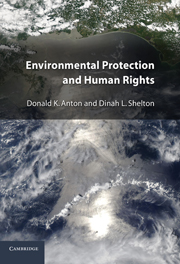Book contents
- Frontmatter
- Contents
- Acknowledgments
- Abbreviations
- Table of Cases
- 1 Law and the Environment
- 2 The Environment as a Human Rights Issue
- 3 An Introduction to Human Rights Origins and Theory
- 4 The International Protection of Human Rights
- 5 International Human Rights Institutions and Procedures
- 6 Procedural Human Rights and the Environment
- 7 Substantive Human Rights and the Environment
- 8 Indigenous Peoples, Rights, and the Environment
- 9 Humanitarian Crises: Armed Conflicts and Other Disasters
- 10 Environmental Rights and International Finance: The World Bank Example
- 11 Human Rights, the Environment, and Corporate Accountability
- Index
2 - The Environment as a Human Rights Issue
Published online by Cambridge University Press: 05 June 2012
- Frontmatter
- Contents
- Acknowledgments
- Abbreviations
- Table of Cases
- 1 Law and the Environment
- 2 The Environment as a Human Rights Issue
- 3 An Introduction to Human Rights Origins and Theory
- 4 The International Protection of Human Rights
- 5 International Human Rights Institutions and Procedures
- 6 Procedural Human Rights and the Environment
- 7 Substantive Human Rights and the Environment
- 8 Indigenous Peoples, Rights, and the Environment
- 9 Humanitarian Crises: Armed Conflicts and Other Disasters
- 10 Environmental Rights and International Finance: The World Bank Example
- 11 Human Rights, the Environment, and Corporate Accountability
- Index
Summary
The Environment Is Man's First Right
Introduction
Over the past sixty years, international human rights law and then international environmental law developed as distinct domains of international law. Almost from the emergence of contemporary international environmental law in the late 1960s, a relationship between the two areas was strongly perceived. In 1972, the governments participating in the first major multilateral conference on the environment, held in Stockholm, proclaimed in the concluding Stockholm Declaration that “[t]he protection and improvement of the human environment is a major issue which affects the well-being of peoples.” Report of the U.N. Conference on the Human Environment, Declaration of the U.N. Conference on the Human Environment, U.N. Doc. A/CONF.48/14/Rev.1, p. 3 (June 5–16, 1972). As we saw in Chapter 1, the Stockholm Declaration also solemnly declared, in the language of human rights, that “[m]an has the fundamental right to freedom, equality and adequate conditions of life, in an environment of a quality that permits a life of dignity and well-being, and he bears a solemn responsibility to protect and improve the environment for present and future generations.” Id. at p. 4 (Principle 1).
During the preparations for the Stockholm Conference and increasingly thereafter, states began adopting constitutional provisions concerning the environment, often using rights language. In the 1980s, the linkage between human rights and the environment recognized in the Stockholm Declaration was enshrined in binding international agreements.
- Type
- Chapter
- Information
- Environmental Protection and Human Rights , pp. 118 - 150Publisher: Cambridge University PressPrint publication year: 2011



